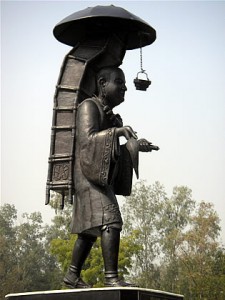Another school derived from the Yogachara School was founded by Hsuan-Tsang (Xuanzang 596-664) based on the writings of Asanga and his half-brother, Vasubandhu. It is also known as the Consciousness-Only School. Hsuan-tsang traveled to India in 629-645 to study Yogachara at Nalanda University. His journey became the inspiration for a very popular classic Chinese novel, Journey to the West.
Hsuan-Tsang was a remarkable spiritual pilgrim who became one of the most famous Chinese Masters. The son of a poor Chinese official, he left home at the age of 13 to study Buddhism. According to a traditional account, “During those early years of study, if there was a Dharma Master lecturing on a Buddhist text, no matter who the Dharma Master was or how far away the lecture was being held, he went, whether it was a Sutra lecture, a Shastra lecture or a Vinaya lecture. He listened to them all. Wind and rain couldn’t keep him away from lectures on the Tripitaka, to the point that he even forgot to be hungry. He just took the Buddhadharma as his food and drink. He did this for five years and then took the Complete Precepts.”
In 629 at the age of 27, having been a monk for fifteen years, he secretly left China and made the dangerous journey across the silk road to India. Sixteen years later, having learned Sanskrit and studied with the best Indian teachers, he returned with an incredible collection of 657 Indian texts, a number of statues of the Buddha and various relics. He was acclaimed by the Emperor who supported him the remainder of his life so he could translate the texts and convey the Mahayana teachings to China. On his deathbed he dedicated his merit so that all present would be born again among the inner circle of Maitreya in Tushita Heaven.
His Cheng Wei Shih Lun (Treatise on the Attainment of Consciousness-Only), a compendium outlining Yogacara doctrine, became the standard text for the Consciousness-Only schools of China and Japan.
He translated many other Sanskrit texts into Chinese including the Perfection of Wisdom Sutras, which filled 600 volumes, Asanga’s Treatise on the Stages of Yoga Practice, the Master of Lapis Lazuli Radiance Tathagata which established the practice of the Medicine Buddha in China and the Far East.
Yogacara Masters After Hsuan-Tsang: Kuei-Chi (638-682 A.D.) was Hsuan-Tsang’s most prominent Chinese student. He systematized the Yogacara teaching and established Yogacara as a distinct school in China, called Fa-hsiang. He also wrote commentaries to Hsuan-Tsang’s Yogacara works including the Fa-yuan-i-lin-chang and the Wei-shih-shu-chi.
Hsuan-Tsang also had several notable Japanese and Korean students. Dosho (628-700) studied with Hsuan-Tsang for ten years sharing a room with Kuei-Chi. When he left to go back to Japan he was given sutras, treatises and Yogacara commentaries to help him establish Yogacara there, which he did, teaching at Bwangoji monastery. His most famous student is Gyogi (667-748). A Korean student Chiho studied with Hsuan-Tsang and also went to Japan to teach. His pupil Gembo went back to China in 716 and was instructed by Chih-Chou, a pupil of Kuei-Chi. Another early Japanese student who studied with Hsuan-Tsang was Chitsu. “Thus,” as Junjiro Takakusu wrote in 1947 in his Essentials of Buddhist Philosophy, “Japan received the orthodox teaching sacrosanct from first-hand authorities of the Indian and Chinese Yogacara School and with the Japanese even now it is the chief subject of Buddhist learning.”
The Fa-hsiang School suffered under the general persecution of Buddhism in China during the middle of the 9th century and gradually disappeared. However, its works are still preserved, and it was revived in the 20th century by several Masters including Ou-Yang Ching-Wu (1871-1943), Abbot Taiuhso (1889-1947, and Hsin Shih-Li (1883-1968), who wrote A New Doctrine of Consciousness-Only in 1944. This revival led to the Hsuan-Tsang’s Cheng Wei Shih Lun being translated into English for the first time in 1973 by Wei Tat, a member of a Hong Kong Yogacara group.

